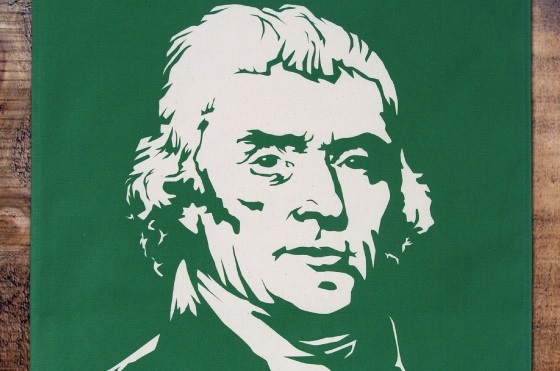Time For Us To Rise: Shays' Rebellion
Posted by Pete on Dec 4th 2018
Thomas Jefferson saw the good side of allowing some expression of discord in the new nation of America - he was referring to Shays' Rebellion of 1786
Typically, our radical tea towel designs are made up of a person's face and memorable statement by them.
In some cases, like Rosa Parks, our message is about highlighting the virtues of the person. In others, it's more about promoting the values expressed by the quote, even if they were expressed with a bit (or even a lot) of hypocrisy.
Thomas Jefferson is a case in point here.
Though perhaps the most radical among the American revolutionary leaders, Jefferson owned African men, women, and children as slaves throughout his life. He also, as President (1801-9), led harsh policies against Native Americansranging from forced assimilation to ethnic cleansing.
Thomas Jefferson was, to put it simply, deeply flawed.
As with our other Founding Fathers designs, then, what we promote with Jefferson is not the man, but the dissenting, emancipatory value of these words he wrote the words: "I hold it that a little rebellion, now and then, is a good thing."

Promises from the revolution had not yet been met
It's a powerful message to gift you with this festive period, especially these days, when we live in a world burdened with so much stuff worth rebelling against - not least people who think Fairytale of New York isn't the best Christmas song...
But even when we've accepted that Jefferson the man didn't entirely live up to the liberal values he put in writing, there is still more for us to celebrate in his quotation than the words alone.
Every quotation has a history, a context. Jefferson's was no exception.
The words "I hold it that a little rebellion, now and then, is a good thing" are found in a letter he wrote to a friend in early 1788 while he was the US Ambassador to France. Jefferson wasn't referring to anything happening in Paris - he was talking about Massachusetts, and the event now known as 'Shays' Rebellion'.
In 1783, the American War of Independence was concluded - the USA was now accepted as a sovereign state. But, as it happened, that didn't resolve all grievances for all people.
Poverty, slavery, economic inequality: these are just some of the things which independence from Britain hadn't even begun to tackle.
Some of the richer Patriot generals and congressmen wanted these things brushed under the carpet of 'victory', but in the summer of 1786 a ragged coalition of New England farmers and war veterans stopped that from happening.
The state government of Massachusetts had refused to issue paper money which could have helped poor farmers - many of them veterans of George Washington's army - pay off their debts.
The farmers weren't pleased.
Shay's rebellion for a real revolution
One, called Plough Jogger, said at a rally: "The great men are going to get all we have and I think it is time for us to rise and put a stop to it."
Organised by 18th century vets, the downtrodden of Massachusetts began to take action.
They demanded the state legislature in Boston address their request for financial relief. In the meantime, Revolutionary War veterans repeatedly marched on county courthouses, preventing the judges from meeting to organise the seizure of livestock and land from debtors.
The American elite was worried by all this popular resistance and lashed out. On 19th September 1786, the Massachusetts Supreme Court, sitting in the town of Worcester, indicted eleven rebel leaders for 'treason'.
Three of the men indicted at Worcester were friends of a Massachusetts man called Daniel Shays.
What was Shays' story? He was a poor farmer who'd joined Washington's army to fight for freedom. Having fought courageously at the Battles of Lexington, Bunker Hill, and Saratoga, Shays resigned in 1780 because, like many frontline troops, he wasn't being paid.
Fast-forward to September 1786, and Shays was leading 700 armed farmers to Springfield to prevent the Supreme Court indicting any more rebel leaders. Like the earlier efforts to stop land seizures, Shays and his rebels were successful - the court adjourned.
Sadly, this was the last victory of the agrarian resistance of 1786.
The beginning of suppression but the start of rebellion in America
The New England winter closed in, making it more difficult for the farmers to march on the courts and, as the clash between farmers and government became violent, an army of regulars was put into the field against Shays.
By early 1787, the rebellion was finished.
Some rebels were hanged, some (like Shays) were eventually pardoned, and the economic justice they had all stood for was left unrealised.
But the rebels did leave us some fruit for thought on post-revolutionary America.
In a time when Americans were told that they had just delivered a revolution against tyranny, these rebels fought against the hypocrisy of that narrative.
What good - they asked - is freedom from King George if those poor men who won it on the battlefields finish up in debtors' prisons?
Many of these rebels suffered jail or worse because the new rulers in America had no good answer for them.
At Christmastime - when we hear much about values of fraternity and compassion from politicians who make a career of bombing the poor abroad and shutting the door on the helpless at home - we can learn much from Shays' Rebellion: the declaration of a just society and the truth of it are two very different things.
Sometimes, "a little rebellion", is needed to make sure the reality matches the ideals.
